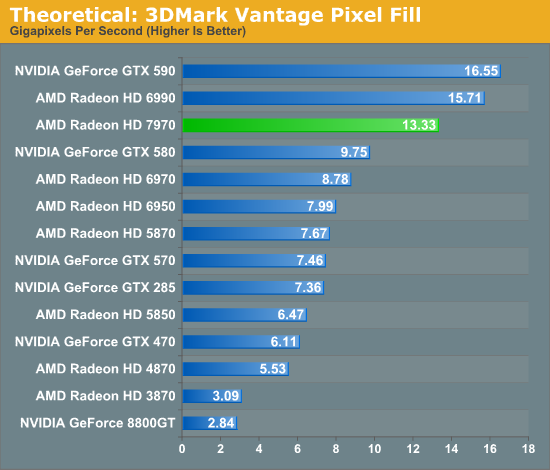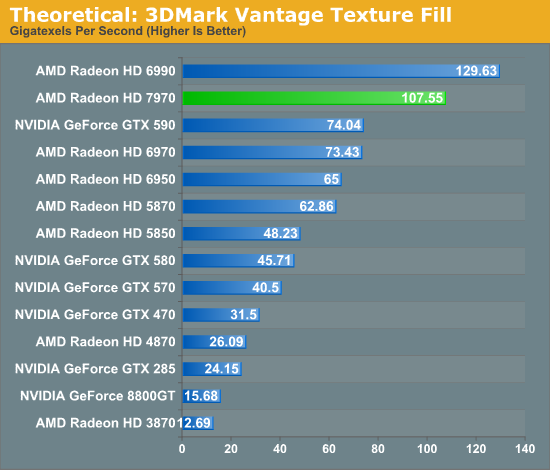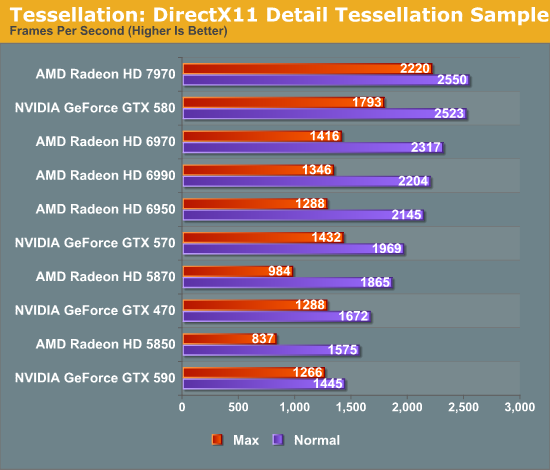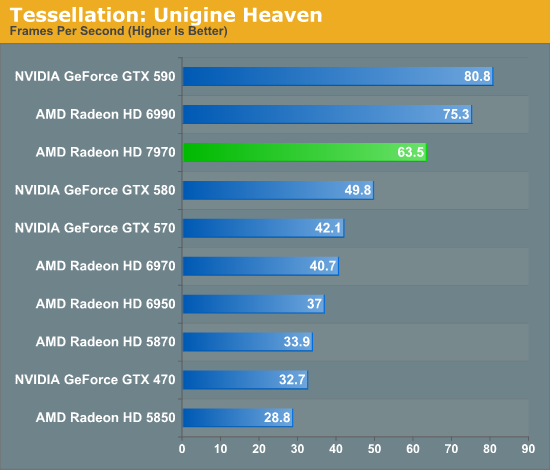AMD Radeon HD 7970 Review: 28nm And Graphics Core Next, Together As One
by Ryan Smith on December 22, 2011 12:00 AM EST- Posted in
- GPUs
- AMD
- Radeon
- ATI
- Radeon HD 7000
Theoreticals & Tessellation
From a rendering perspective one of the most interesting things AMD did with Tahiti was what they didn’t do: they didn’t add more ROPs, they didn’t add more geometry engines. And yet based on our game performance they’ve clearly improved on their performance in those situations by making more efficient use of the hardware they do have.
So we wanted to take a quick look at synthetic performance to see what these tools had to say about AMD’s changes. We’ve included the numbers for every other GPU in our lineup as a reference point, but we would strongly suggest against reading into them too much. AMD versus AMD is sometimes relevant to real world performance; AMD versus NVIDIA rarely is.

We’ll start with 3DMark Vantage and its color fill test. This is basically a ROP test that attempts to have a GPU’s ROPs blend as many pixels as it can. Theoretically AMD can do 32 color operations per clock on Tahiti, which at 925MHz for 7970 means the theoretical limit is 29.6Gpix/sec; not that any architecture is ever that efficient. In practice 7970 hits 13.33Gpix/sec, which is still well short of the theoretical maximum, but pay close attention to 7970’s performance relative to 6970. Even with the same number of ROPs and a similar theoretical performance limit (29.6 vs 28.16), 7970 is pushing 51% more pixels than 6970 is.
In designing Tahiti AMD said that they didn’t need more ROPs they just needed more efficient ROPs, and it looks like they’ve delivered on this. It’s not clear whether this is the limit for efficiency or if AMD can squeeze more out of their ROPs in future designs, but this definitely helps to prove that there’s more to graphics rendering than a large number of functional units.

Our other 3DMark synthetic benchmark is the 3DMark Vantage Texture Blend test, which measures how quickly a GPU can blend multiple FP16 textures. This is more synthetic than most tests because FP16 textures aren’t widely used, but it’s a consistent benchmark.
The theoretical performance improvement from 6970 to 7970 is 40% - 33% more texture units operating at a 5% higher clockspeed. In practice the 7970 exceeds that improvement by increasing texture performance by 46%, meaning the 7970 has benefitted from more than the increase in texture units. Most likely the new cache architecture has further improved the efficiency of the texture units, although the 3DMark texture set is not particularly large.
Moving on, we also wanted to take a look at tessellation. AMD did not increase the theoretical geometry performance of Tahiti as compared to Cayman – both top out at 2 triangles per clock – but AMD has put a lot of effort into improving the efficiency of Tahiti’s geometry units as we’ve seen reflected in our game benchmarks.

Our first tessellation benchmark is the traditional Detail Tessellation sample program from the DirectX SDK. Here we’re looking at tessellation performance as a product of the framerate, testing at tessellation factors 7 (normal) and 15 (max). Traditionally this is a test that has been rather balanced at normal tessellation levels, while NVIDIA cards with their superior geometry throughput have been the top performers at maximum tessellation levels. So it’s all the more interesting when we’ve seen the tables turned; the 7970 is merely competitive with the GTX 580 at normal tessellation levels, but now it’s ahead of the GTX 580 by 24%. More significantly however the 7970 is ahead of the 6970 by 57%.

Our second tessellation benchmark is Unigine Heaven, a benchmark that straddles the line between a synthetic benchmark and a real-world benchmark, as the engine is licensed but no notable DX11 games have been produced using it yet. In any case the Heaven benchmark is notable for its heavy use of tessellation, which means it’s largely a proxy test for tessellation performance.
As with the Detail Tessellation sample program, Heaven shows significant gains for the 7970 versus the 6970, with the 7970 leading by 56%. Meanwhile it leads the GTX 580 by 27%, which is actually slightly better than what we saw under the more “pure” Detail Tessellation sample. Between these two benchmarks it’s clear that AMD’s tessellation efficiency improvements are quite real, and that with Tahiti AMD can deliver much better tessellation performance than Cayman even at virtually the same theoretical triangle throughput rate.
Of course one has to wonder what NVIDIA will have in store for Kepler next year. Their current Fermi design seems to scale well with additional geometry units, but if Tahiti is anything to go by, there’s a great deal to be gained just by focusing on efficiency. NVIDIA has prided themselves on their geometry performance since before GF100 even shipped, so it will be interesting if they have anything in store to hold on to that distinction.










292 Comments
View All Comments
Scali - Monday, December 26, 2011 - link
Lol, how's that, when I'm the one saying that AMD's cards are the best performers in Crysis 2?I'm neutral, a concept that is obviously alien to you. Idiots...
Scali - Monday, December 26, 2011 - link
Heck, I'm also the guy who made Endless City run on non-nVidia cards. How does that make me an nVidia fanboy?CeriseCogburn - Thursday, March 8, 2012 - link
That's sad when an nvidia fanboy has to help all the amd fannies with software coding so they can run a benchmark, then after all that work to help the underprivileged, nothing but attacks after the facts... finally silence them.It's really sad when the truth is so far from the pop culture mind that actually speaking it is nearly forbidden.
Thank you for helping them with the benchmark. Continue to be kind in such ways to the sour whining and disgruntled, as it only helped prove how pathetic amd dx11 was...
james007 - Friday, December 30, 2011 - link
This sounded like such an awesome card and I was psyched to get it the moment it comes out -- until reading the part about dropping the 2nd DVI port. A DisplayPort-to-SLDVI doesn't do it, for me, because my desktop has to drive two 30" displays. In fact, I would love to be able to drive a third display so I can have a touch-screen also. My current (previous-generation) VDC does drive both displays just fine.This does not seem like such an infrequent requirement, especially for high-end users. Why would they drop the ability to drive the 2nd display? !!!
Argh!
The_Countess666 - Saturday, December 31, 2011 - link
not trying to sell you anything but, HDMI to dual-link dvi does exist (see link, or google yourself for other shops).http://sewelldirect.com/hdmi-to-dvi-dual-link-cabl...
and these cards do have 1 HDMI-out so that should work for you.
Penti - Wednesday, January 4, 2012 - link
It's the IHV that makes those decisions any way, just because it's not on a reference card doesn't mean they won't show up or that you can't build a card with it. But the HDMI supports more then 1920x1200 finally on this card any how. I guess they could deliver a card with the old type of DVI>HDMI adapters. Obviously opting for HDMI and multidisplaycapable displayport 1.2 makes more sense though. It's been around for years now.Penti - Wednesday, January 4, 2012 - link
Just make sure you actually has the number of connections you need when buying the card, many 7970 bords only appear to support single-link DVI on the DVI-connector.poordirtfarmer2 - Wednesday, January 4, 2012 - link
Enjoyed the article.So this new 79XX architecture is about a GPU architecture that’s also good for “compute work”. The reference to NVIDIA ‘s professional video cards (Quadro ; Telsa), implies to me that this might mean video cards viable for use both in gaming and in engineering / video work stations.
I’m not a pro, but do a lot of video editing, rendering and encoding. I’ve avoided dedicating a machine with an expensive special purpose QUADRO video card. Am I reading the wrong thing into this review, or might the new 79XX and the right driver give folks like me the best of both worlds?
radojko - Thursday, January 5, 2012 - link
UVD 3 in NextGen is a disappointing. Nvidia is two generation in front with PureVideo HD 5.psiboy - Monday, January 9, 2012 - link
Well Mr Ryan Smith I must ask why the omission of 1920 x 1080 in al lbenchmarks... given that almost every new monitor for quite some time has been natively 1920 x 1080... what is it with you guys and Tom's lately.. you both seem to have been ignoring the reality of what most of your readers are using!